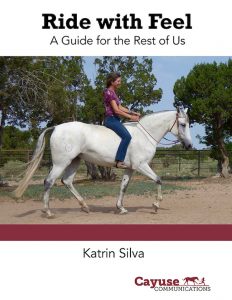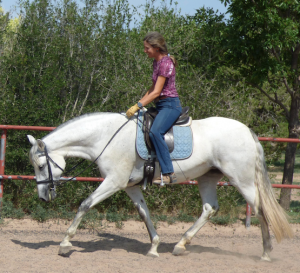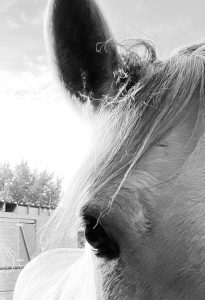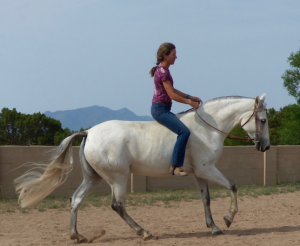 Editor’s Note: Best Horse Practices Summit presenter Katrin Silva grew up riding dressage in Germany before moving to the United States at age 19 to learn to ride Western. She’s been riding both disciplines for the last 20 years and is a regular guest columnist for Cayuse Communications. The author of Dressage for All of Us: How to Help Any Horse Become a Happier, More Responsive Riding Partner and the forthcoming Ride with Feel: A Guide for the Rest of Us lives in New Mexico where she works with dressage and Western clients.
Editor’s Note: Best Horse Practices Summit presenter Katrin Silva grew up riding dressage in Germany before moving to the United States at age 19 to learn to ride Western. She’s been riding both disciplines for the last 20 years and is a regular guest columnist for Cayuse Communications. The author of Dressage for All of Us: How to Help Any Horse Become a Happier, More Responsive Riding Partner and the forthcoming Ride with Feel: A Guide for the Rest of Us lives in New Mexico where she works with dressage and Western clients.
Katrin writes:
They say dogs and their owners start to look alike after they’ve spent enough time in each other’s company. Something similar is going on with horses and their riders. While we might as well admit that even the most attractive human will never look as beautiful as the average horse, we still mirror each other. Horses go the way we ride them; it’s a simple truth that happens on every level – physically, mentally, and emotionally.
 The physical stuff may be most obvious. Horses compensate for their riders imbalances. My working student had a lightbulb moment when she realized the horse she was riding hollowed his back in canter transitions, not because he was resistant to her aids, but because her elbows were rigid.
The physical stuff may be most obvious. Horses compensate for their riders imbalances. My working student had a lightbulb moment when she realized the horse she was riding hollowed his back in canter transitions, not because he was resistant to her aids, but because her elbows were rigid.
“He doesn’t have a hard mouth! I have hard hands!” she realized.
I know how she felt because horses point out my bad habits to me all the time. They never lie. When my back gets tight, my horse’s back gets tight. When my right shoulder drops, my horse quits bending to the right. When I slump in the saddle, my horse loses cadence and forward energy. But when I sit tall, straight, and relaxed at the same time, my horse’s movement becomes rhythmic and elastic, which makes both of us much happier.
A similar mirroring process happens mentally and emotionally. This may be because our bodies and our minds are not as separate from each other as we’d like to believe, or it may be because our horses are so sensitive that they can literally read our minds. Regardless, we’ve all experienced days when a horse feels more tense or anxious than usual and when, on reflection, we’re the ones who made them that way because we brought our worries into the saddle. I make a conscious effort to not listen to the news on my way to the barn, because I don’t want to arrive feeling helpless and frazzled. My horses pick up on these emotions, which is not fair to them. When I ride with joy and serenity, my horses reflect that, too.
 Because horses mirror us, I can get on a horse someone else has been riding and find out a lot about that person – not just about her competence and educational level as an equestrian, but about who she is. Anyone riding my horses will learn about me, too. Horses know whether someone is calm or nervous, confident or insecure, trustworthy or just pretending to be. Horses reflect the human on their back, without flattery or calculation. They can reveal what we try to hide from others, like anger management issues or deep-seated fears. They don’t lie to us. We can’t lie to them. They see right through us.
Because horses mirror us, I can get on a horse someone else has been riding and find out a lot about that person – not just about her competence and educational level as an equestrian, but about who she is. Anyone riding my horses will learn about me, too. Horses know whether someone is calm or nervous, confident or insecure, trustworthy or just pretending to be. Horses reflect the human on their back, without flattery or calculation. They can reveal what we try to hide from others, like anger management issues or deep-seated fears. They don’t lie to us. We can’t lie to them. They see right through us.
Of course, it’s a two-way mirror. The way we ride today reflects all the horses we’ve ridden before today – and, by extension, the people who have shaped them into who they are. Quiet, sensitive riders usually have a sensitive horse to thank for developing this talent.
Tactful riders have become that way on horses who would not tolerate anything less. Educating young horses or re-educating troubled horses is not something we can learn from watching videos or from riding only well-schooled horses. This skill set is reserved for those riders who spend lots and lots of time around such horses. When I think back to all the horses I’ve worked with, the ones who stand out are not the ones who made me look good because they were easy. I feel a huge debt of gratitude remembering all the complicated individuals who did not respond to my usual approach and made me question everything I thought I knew and ultimately had me expanding my horizons. These horses have taught me more than any dressage clinician ever did.
 Whether we’re aware of it or not, we leave our mark on every horse we ride, like footprints on wet sand. The longer we ride a horse, the deeper our prints become and the harder they are to erase. Horses also leave their marks on us, in the form of patience, humility, confidence, and connection. Maybe that’s what building a partnership means: becoming aware of the power we have to shape a horse’s body and mind, and the horse’s power to shape ours. We can make a conscious effort to leave positive impressions on our horses, while thanking them for giving us the qualities we need to ride better, and do more than simply survive in today’s world.
Whether we’re aware of it or not, we leave our mark on every horse we ride, like footprints on wet sand. The longer we ride a horse, the deeper our prints become and the harder they are to erase. Horses also leave their marks on us, in the form of patience, humility, confidence, and connection. Maybe that’s what building a partnership means: becoming aware of the power we have to shape a horse’s body and mind, and the horse’s power to shape ours. We can make a conscious effort to leave positive impressions on our horses, while thanking them for giving us the qualities we need to ride better, and do more than simply survive in today’s world.